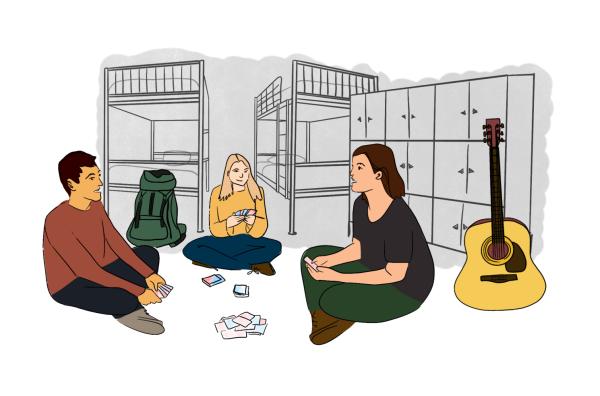International Students Studying Remotely Face Challenges During Fall Semester

As the campus continues its reopening effort amid the COVID-19 pandemic, international students studying remotely face academic and social challenges. With difficulties in scheduling and accessibility, remote international students in different time zones adapt to remote learning and socializing in creative ways, at times with faculty accommodations.
Senior Molly Meng is studying at home in Beijing, China with a 12-hour difference EDT and a 13-hour difference during non-Daylight Savings time.
“Most of my classes start in between 11 p.m. and 4 a.m. Beijing Time, so I stay fully awake during this time period, and then go to bed around 6 a.m., wake up at 12 p.m. and begin to plan my schedule in the afternoon,” Meng said.
Students in other time zones, such as first-year student Josh Docking studying in Coventry, England with a five-hour time difference, also found it helpful to adjust their sleep schedules to course schedules.
“On Tuesdays and Thursdays I’d start classes at 1:30 p.m. and finish at about 1 a.m. My sleep schedule gets me about seven to eight hours of sleep from 4 or 5 a.m. to 12 p.m.,” Docking said.
Besides making changes to his sleep schedule, Docking often found himself eating meals at different times than his family.
“My meal times are where I struggle the most really,” Docking said. “Because while all of my family are eating dinner, I’m usually either in class or just not hungry, so I’ve had to start making separate meals for myself later on without disturbing anyone.”
Other students took time differences into consideration while registering for classes. Junior Elena Li double-concentrates in international relations and theater while studying remotely in China with a 12-hour difference.
“Uncertainty about remote [modes of instruction] during the time of registration was the biggest thing,” Li said. “I didn’t really know which time zone I was choosing with. As a compromise, I chose two morning-classes and two afternoon-classes. A lot of [international relations] courses I was interested in are scheduled to be in the afternoon, but there are limits to that. I don’t think I would take a 3:35 to 4:50 a.m. [course] because that would be too much.”
However, Li still found her classes considerably disruptive to her schedule.
“Classes go on till 3:15 a.m. on three nights a week, and 1:40 a.m. on another night. I don’t have a fixed time for eating, basically whenever I have a break from studying,” Li said.
Many remote international students have received resources that enable them to access parts of their course materials asynchronously and are appreciative of such faculty effort. Some professors have also been more flexible with deadlines and exam schedules for international remote learners.
“[Associate Professor of Film and Media Studies Ani] Maitra told me to assure my sleeping schedule before catching up with papers and offered both available recorded lecture videos and great flexibility on assignment deadlines,” Meng said.
While many faculty members have offered students lecture recordings and other asynchronous resources that accommodate time differences, many still find synchronous learning indispensable to Colgate’s Liberal Arts education. Professor of Biology and Environmental Studies Timothy McCay requires all students in his Biostatistics class to interact synchronously each week even though most of the class material is accessible asynchronously through online recordings.
“Recording lectures allows for very precise delivery of material, but it will never take the place of in-person classes. Only by being in-person in the same place can I really tell how well students understand things and adjust accordingly,” McCay said.
To optimize synchronous interactions and class discussions, Senior Lecturer in Writing and Rhetoric and Coordinator of Second Language Writing Suzanne Spring opened a second section at 10 p.m. of her FSEM seminar, Rhetoric/Research-Public Sphere, for two remote international students, while welcoming other remote and on-campus students to take the class at a time of their choice.
Despite accommodations to international student schedules, faculty and students also expressed regrets over not being able to interact with everyone in the class and on campus in academic or social settings.
“It is also disappointing to not have an easy way for all of the 18 students in the FSEM to get to know each other,” Spring said. “A couple of the students in the 3:35 [p.m.] section have expressed sadness about this as well, saying that we are incomplete as a community without everyone being here on campus.”
First-year Aranya Pal is studying at home in Bengal, India and expressed his wish to be on campus and meet students and professors in-person.
“I think my experience as a remote learner has been different from people on campus in the sense that I feel more like an isolated learner, I guess. Also, I am really unhappy that I am not able to meet professors in-person; that is something that I had been really looking forward to,” Pal said.
Besides time differences, technical difficulties have also posed significant obstacles for international students studying remotely. Students who attend classes remotely while the rest of their classes learn in-person often find it difficult to hear their professors and classmates clearly. As a result, remote students are often unable to keep up or participate in class.
“The biggest problem I have is with hybrid classes in tents. We can barely hear the professor over the wind let alone the classmates. It was worse than just Zoom,” Li said. “Professors are trying really hard though, but it’s just horrible.”
“During my [hybrid] Legacies class, I can hardly hear what my professor and class was talking about,” first-year Rebecca Zhu said. “For a class that talked about literature like that, I found it hard to keep pace with the rest of the group.”
Faculties have also tried to improve the audio qualities for remote learners. Zhu said Professor of Literature Margaret Maurer spent a great deal of effort ensuring an optimal learning experience for her in her Legacies class.
“After I informed my Legacies professor about the situation of [where] I cannot hear clearly on the Zoom meeting, she switched to another room and kindly asked me whether I wanted to have an individual meeting,” Zhu said.
Besides challenges during class time, remote international students have also faced difficulties with access to essential resources for their classes. Meng found internet and textbook access to be two of the most challenging aspects of studying from home in Beijing, China, where access to many foreign websites and resources including Google, Gmail and Youtube is restricted without VPN. Pal and Docking also struggled to purchase textbooks.
“I had a tough time organizing all the books required for my classes, as they are not really available in India, so I am using a combination of e-copies and paperbacks which is a little troublesome,” Pal said.
“It was quite difficult to get a hold of some textbooks. I was trying to rent one of my textbooks online for the semester, but I couldn’t because it was only available on the U.S. VitalSource store and I don’t have a U.S. payment method, so I couldn’t pay,” Docking said. “But I contacted the Colgate Bookstore and they helped me rent the book, so now I have all the books I need.”
Aside from limited access to current course materials, remote international students also faced obstacles in course registration. Course registration took place from June 1 to June 3, 2020, before instructors determined the course instruction modes around Aug. 5. The first Drop/Add period ran later from Aug. 9 to Aug. 21, 2020. In a Colgate update released on July 6, Colgate clarified that “students who do not return to the campus for the fall semester will have the opportunity to participate in their courses remotely. Some courses will be taught in a mixed format — with some students remote, and others on campus — while others will be taught entirely in a remote format.”
However, as remote students found out that some of the classes they wanted to take were only offered in-person, they either chose or were encouraged to switch to classes with different instruction modes. Senior Carly Yang, who is from China but chose to study remotely from New York City, had to switch into two different classes from her original picks. Yang’s economics and art professors offered the classes in-person and recommended Yang seek other classes. Yang refused to identify the specific classes she had to switch from, but she did wish professors would have been more flexible with instruction modes.
“They shouldn’t have discouraged me from taking the classes just because I’m remote,” Yang said. “It’s such a difficult time for everyone and I think professors should be more accommodating of people’s different situations. I didn’t need those classes and luckily I got into [new] classes I liked, but if I really needed those classes, I would be put in a very difficult position just because they decided remote learning is not enough.”
Meanwhile, Associate Professor of History Alan Cooper sought creative ways to accommodate remote learners in his in-person classes. Professor Cooper is teaching three in-person classes this semester. However, he makes them accessible to remote students in multiple ways.
“Professor Cooper [reserved] a multimedia classroom for his in-person course. Every student must bring laptops and use Zoom while listening to his in-person lecture. In this case, students like me who are doing remote learning can listen to the lecture and participate in the class discussion via Zoom,” Meng said. “Professor Cooper also offered lecture recordings in case my internet connection dropped and told me about a recording transcription software where I can see what people are talking about in writing if I can’t hear them clearly.”
Beyond logistical difficulties and creative efforts by students and faculty, remote international students like sophomore Nandini Krishna also found that some learning environments posed challenges to their learning outcomes.
“The issue for me lies more with the engagement,” Krishna said. “I think being in a classroom or having the environment of a library or common room where everyone is studying is actually very motivating and instills this air of productivity that I’m finding hard to recreate at home.”
The decision to study remotely is a difficult one for many international students as many were caught in a hurdle between optimal learning experiences and travel restrictions, financial stresses, consulate policies, health risks and expenses as international students in the U.S.
In a campus-wide email sent Tuesday, June 30, students were asked to indicate whether they would be studying remotely by July 9. This was amid ICE (U.S. Immigration and Customs Enforcement) guideline changes on July 6 which required international students to return to their home countries if their fall courses were fully online. ICE rescinded such changes on July 14 and released a final clarification on its policies regarding international students’ eligibility to study in the U.S. on July 24. In an email sent to international students by Colgate Office of International Student Services (OISS) on July 24, international students were asked to indicate their decision between remote or on-campus learning no later than July 30.
Docking was unable to obtain his U.S. visa by the time he needed to make the decision to study either remotely or on campus and flight ticket prices surged as his travel date approached.
“We would be booking flights so close to the date of travel, and a lot of flights were cancelled because of COVID, plane tickets were getting super expensive. Considering my family has barely enough to cover me attending Colgate even with financial aid, it just wasn’t a viable option,” Docking said.
Pal decided to take classes remotely mainly due to the U.S. Consulates in India closing, which cancelled immigrant and nonimmigrant visa appointments from March 16, 2020 to Aug. 17, 2020. Pal also took COVID-19 related health risks in the U.S into consideration.
“[The U.S. Consulate] had been closed since March, there was absolutely no news that they would open, till they suddenly did, on [Aug. 17]. By then I had already decided to be remote and paid my fees as a remote learner. Undoing all of that, going for an interview that would have been just days away and leaving on such short notice without any prior planning would have been a great hassle,” Pal said. “My parents also were slightly worried about the whole situation of the pandemic in the U.S., but now they are more worried about the situation here at home.”
Li also points to visa reapplication risks posed to international students by politics.
“I’m worried about visa status and prospects about reapplication given current China-U.S. relations. Technically I don’t feel like attending remotely counts as attending college. It’s just taking online classes. It adds to the educational experience, but not in the way I expected, not why I came to the U.S. for college. It’s just a compromise that one has to make in extreme circumstances,” Li said.
Despite challenges posed by remote learning, many remote learners appreciated Colgate’s efforts in making the best out of a very difficult situation.
“I think Colgate has done an exceptional job in their set up of this semester and while the students studying remotely are definitely a minority, I haven’t felt brushed aside at all. In fact, I think the administration is going out of their way to ensure remote students feel taken care of,” Krishna said.
Many remote international students also recognize some positive aspects of remote learning. Pal and Docking said remote learning has trained them to become more self-motivated and do better work from home.
“I will certainly value my college experience far more, for one. Also, I feel that a remote learning experience is making me far more self-sufficient,” Pal said.
“I don’t often see training available for work-from-home jobs so this is almost like training to cope with working from home in a real job,” Docking said. “I also think it’s increasing my confidence in video calling, as I used to hate showing my face on camera, but now I kind of don’t have a choice so I’m realizing that there’s not much to lose by turning my webcam on and showing my face.”










